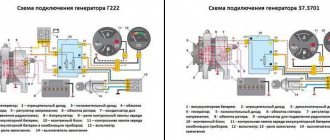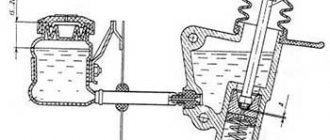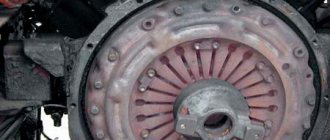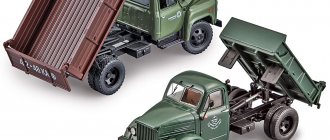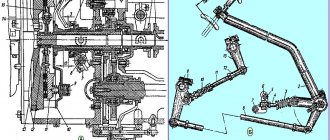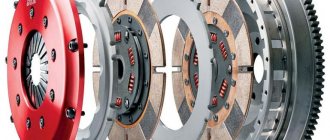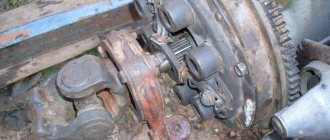Methods for detecting and eliminating MAZ clutch failures
The clutch and its drive, installed on MAZ heavy-duty vehicles, have repeatedly proven their reliability, efficiency, durability and high performance characteristics. But, unfortunately, each mechanism has its own strength limit, upon reaching which it requires lubrication, cleaning and repair work, and sometimes complete installation. Next, we will look at common MAZ clutch failures, signs of their occurrence and ways to eliminate them. We classify all possible breakdowns according to the type of manifestation.
Features of the MAZ double-disc clutch
A classic of dry-type clutches produced in Minsk is the MAZ double-disc clutch, which is mounted on a MAZ vehicle. The springs of this unit are located peripherally and this is its main difference from other devices. The quality indicators of the springs may have different indicators, but this does not change the operation of the clutch.
The direct task of a double-disc clutch is to transmit high-quality torque; for this, the middle and pressure drive disks have two pairs of remote contacts located on the plane of the spring device. Contact-directed tides work with the flyshaft, thereby transporting the entire assembly along the axis in the absence of any obstacles. These are the basic principles of operation of a MAZ double-disc clutch.
Source
Clutch slipping
The pedal should respond clearly to pressure and have precisely adjusted free play. Often the clutch begins to slip due to the fact that the cylinder piston becomes clogged and jams. In order for it to stop jamming, you need to remove it and rinse it thoroughly in kerosene; these simple technologies are used on almost all oil-based automotive parts at MAZ. If obvious defects and damage are detected, replace the faulty parts with new ones. Similar manipulations should be carried out with the amplifier valve if the source of the malfunction lies precisely in it. The friction linings of the driven disks are subject to constant load and, accordingly, increased wear. During regular maintenance, assess their condition and replace components that are unsuitable for further use.
The clutch disappears on the oil
alas, no photos, the bvl repair was done in a hurry and was fixed, one might say, on the fly.
Before lunch, while leaving the field from unloading, the clutch pedal suddenly suddenly stopped being pressed. And the air in the counter dropped to almost 4 degrees. Somehow I got to the farm, where all my workmates were already standing for lunch. It turned out that the pipe on the clutch PGU had burst. The previous one drove, when I changed the PGU, screwing the tube on, it was slightly bent, and it rubbed against the second tube on the PGU. And it burst or frayed at the bend.
I cut off a piece of the tube, it was long enough to connect - an old nut, a new barrel, an elastic band, an insert into the tube, assembled everything, clamped it, started it - there was air, there was a clutch. And I began to keep air in the system a little longer. But it still leaks somewhere.
In previous articles, we discussed the issue of repairing the MAZ clutch and its design.
Today we offer some useful tips to help you adjust the MAZ clutch.
We will also tell you how to bleed the clutch on a MAZ.
Incomplete shutdown
This problem in most cases is due to the fact that the pedal has become loose and its free play has exceeded the permissible limits. Make some fine adjustments and everything will return to normal. A similar cause of malfunction is a violation of the adjustment of the rod dimensions. Mechanics should carefully inspect the pneumatic air supply system, as low pressure levels can cause further problems. Due to the loss of tightness by the piston collar, problems associated with partial disengagement of the MAZ clutch may also occur. Regularly inspect and replace system components such as the pressure plate, release arms and clutches.
Clutch MAZ-4370 Cog assembly SASSONE 348212551218780015013151000079 — Leave a review
Article: 3482125512/1878001501/3151000079, additional articles: 6187ST/7998/8998, 15 3482 1255 12
Order code: 644718
- Buy analogues
- Trucks and trailers / GAZ / GAZ-33106 Euro 31 drawing
- Driven clutch disc Clutch / Clutch installation 33106-1601004
- Driven disc Clutch and gearbox / Installation of the clutch. Installing the clutch housing with the gearbox
- Driven disc Clutch and gearbox / Installation of the clutch. Installing the clutch housing with the gearbox
- Pressure disc Clutch and gearbox / Installation of the clutch. Installing the clutch housing with the gearbox
- Driven disc Clutch and gearbox / Installation of the clutch. Installing the clutch housing with the gearbox
- Driven disc Clutch and gearbox / Installation of the clutch. Installing the clutch housing with the gearbox
- Pressure disk with casing D-245.9E4-4020 / Crank mechanism. Installing the crankshaft pulley. Installing the clutch.
- Driven disk D-245.35E4 (for MAZ) / Crank mechanism. Installing the crankshaft pulley. Installing the clutch.
- Driven diskEngine / Installation of piston group. Crankshaft and flywheel. Installing the clutch. Fan Clutch Installation
- CLUTCH DISC DRIVEN Engine / Installation of piston group. Crankshaft and flywheel. Installing the clutch. Fan Clutch Installation
- Driven diskEngine / Installation of piston group. Crankshaft and flywheel. Installing the clutch. Fan Clutch Installation
- Driven diskEngine / Installation of piston group. Crankshaft and flywheel. Installing the clutch. Fan Clutch Installation
- Pressure diskEngine / Installation of piston group. Crankshaft and flywheel. Installing the clutch. Fan Clutch Installation
- Pressure disk with casingEngine mechanisms / Crank mechanism. Flywheel installation. Pulley installation. Installing the clutch.
- Clutch release Attached to the engine / Attached to the engine.
- There are no reviews for this product yet.
- Clutch MAZ-4370 Gear assembly SASSONE Article number: 3482125512/1878001501/3151000079, 6187ST/7998/8998, 15 3482 1255 12 Order code: 644718
The pedal does not return to its initial position
Very often, drivers turn to specialists for help with a number of problems related to the slow, uneven or incomplete return of the clutch pedal to its base position after pressing. Estimate the tension force of the return spring. If the above indicators are normal, then the reason for poor performance may be hidden in worn valves, severe contamination, corrosion or deformation of mechanism components. Carry out the lubrication and cleaning work specified in the technical documentation to avoid jamming of the rod and levers and jamming of the piston.
Source
MAZ-4370 “Zubrenok”: technical characteristics
MAZ-4370 “Zubrenok” is a medium-tonnage low-bed truck manufactured by the Minsk Automobile Plant. An N2 class vehicle, MCV category, which was produced by MAZ in the early 2000s (in the 2010s it was replaced by the MAZ-4371 Zubrenok-2). The truck is designed for intracity and suburban transportation: it is soft, roomy, maneuverable and very convenient, thanks to the low frame, for loading and unloading operations. “3ubryonok” is the unofficial name of the model. Although there were rumors about its introduction as the factory name of the car - in those years when “3ubryonok” was still competing with “ZIL Bychko” and “GAZ Valdai”.
A little history
The first samples of a new class of truck - a low-bed, medium-duty delivery vehicle, very much in demand in the market of new Russia - were created by MA3 in the late 1990s together with the Gorky Automobile Plant. Despite the fact that the Soviet Union was put to death, the economic ties developed over decades remained strong for a long time. But later, without bringing the project to completion, each manufacturer went their own way. The Minsk Automobile Plant unilaterally refused to supply GAZ with its MAZ-5336 type cabs. And when creating our own medium-tonnage delivery truck, we took the German MAN L 2000 as a basis. Only it was decided to add load-carrying capabilities to it, and in the summer of 1999 the first MA3-4Z70 “3ubrenok” left the factory gates.
Why does the clutch slip?
Mechanical, robotic, and some CVT transmissions transmit rotation from the engine to the wheel drives through the clutch. Depending on the driving style and type of gearbox, its average service life is 50–150 thousand km. The need to replace it is indicated by disc slippage. But the clutch does not always slip only due to wear. The reason may lie in contamination or incorrect settings. The exact answer to the question “Why does the clutch smell when you slip?” you will find in the article.
How to replace
Replacing the clutch is carried out in several stages:
How to remove
In order to dismantle the coupling mechanism, you must perform the following steps:
- Place the vehicle on a special platform or inspection hole.
- Remove the battery.
- Remove the air filter element.
- Remove the engine splash guards, which are located in the lower and side parts of the power unit compartment.
- Remove the front suspension cross member.
- Remove the front drive wheels.
- Drain the oil fluid.
- Disconnect the speed sensor using a screwdriver.
- Remove the reverse switch.
- Remove the engine harness holder.
- Unscrew the mounting bolts and remove the starter housing.
- Disconnect the engine mounts from the gearbox bracket.
- Move the clutch back.
- Remove the input shaft of the mechanism.
- Unscrew the mounting bolts from the coupling mechanism housing. The bolts are unscrewed one by one, in 2-3 steps.
- Remove the pressure plate along with the casing.
Assembly
Clutch mechanism assembly steps:
- Assemble the driven disk. To do this, it is necessary to attach friction linings to a plastic spring device.
- Assemble the pressure plate. You need to lubricate the rollers with a special liquid, place them in the hole of the pull handles, insert the lever into the groove that is located on the pressure-type disk, and install the finger. Attach the support forks to the levers and secure them with cotter pins.
- Assemble the pressure disk with the casing. This must be done under a press that can compress the springs and screw the bolts into the support forks. A driven type disk is placed under the press, and a pressure disk is placed on top. Heat-insulating washers and the spring mechanisms themselves are installed on special protrusions. Press the casing using a press and tighten the mounting bolts.
- Installing discs into the clutch housing.
Procedure for installing the clutch:
- Install the driven disc so that the extended end of the hub faces the flywheel.
- Install the drive disk element with rods.
- Install a second driven disk with the elongated end of the hub pointing towards the gearbox.
- Install the pressure plate.
- Attach the cut adjusting rings to the structure.
- Install the stop bars and secure them with the casing.
- Install the clutch mechanism on the flywheel, check the gap between the thrust rings and washers by engaging the clutch mechanism.
Signs of a slipping clutch
If the clutch of a car is slipping, signs of this malfunction can be easily noticed. The car starts softer and takes longer to accelerate. Also, when you try to quickly pick up speed, the engine speed fluctuates, and an unpleasant smell of burnt friction linings comes from under the hood.
All the tips on how to understand that the clutch is slipping, and the main reasons for the malfunction of this transmission unit, are collected in the table below.
| Why the clutch slips: reasons for slipping and what to do | ||
| Indirect signs | Causes | How to fix? |
| The clutch is not fully depressed, a smell appears when the pedal is pressed for a long time | Insufficient pedal travel, incorrect drive adjustment | Adjust the pedal and clutch drive, check the release bearing |
| The clutch slips when the pedal is fully released | Dirt and oil on friction discs. Usually occurs after repairs, careless oil changes, and also if the cylinder head gasket, crankshaft seal or gearbox input shaft leaks. | Wash the disc, flywheel and basket with gasoline or other solvent and dry |
| The clutch does not release or is pressed too easily, gears shift with jerks, crunches and only when the synchronizers are activated | Failure of the hydraulic or mechanical drive of the squeezing mechanism | Replace faulty parts of drive mechanisms and adjust them |
| Failure of the diaphragm spring of the release mechanism | Replace the clutch basket with a new one | |
| The revs fluctuate, the car takes a very long time to accelerate or does not move at all in any gear. | Critical wear of the friction layer | Replace clutch driven disc |
| The clutch slips jerkily, especially when trying to accelerate sharply, vibrations go through the body | Flywheel deformation, uneven wear of the friction surface | If there is slight wear, grind and balance the flywheel; if there is significant wear or deformation, replace it with a new one. |
| Extraneous sounds (crunching, howling, knocking) when the pedal is depressed, problems with gear shifting, too tight or soft pedal travel | Release bearing wear | Replace the faulty bearing with a new one, adjust the drive mechanisms |
Which clutch kits are better: opinions of car owners
“I had a German Sach kit consisting of a basket and a disc. I drove about 230 thousand km with it, during which the forks and release bearings were changed twice. At the moment I am using a Turkish product from Kraft. Comparing it in the store with the “German”, I did not notice any design differences. Moreover, the Turkish kit is cheaper. So is it worth overpaying?
“The factory clutch on my VAZ-2112 lasted 67 thousand km. During this time, the friction linings were worn out almost completely. Today I finally changed the kit along with the basket and release plate. For a long time I was choosing between products from Valeo, Sachs and VIS, but in the end I settled on the option from Luk. Namely, we chose Luk Priora, which is included in the basic configuration of this car. I was mainly guided by positive reviews from experienced drivers regarding stable torque.
It is noteworthy that the first batches of this product, judging by the description, contained copper rivets, and later ones were silver and without inscriptions. The clutch disc looks high quality and neatly made, and the basket also inspires confidence with its appearance.
The release disc has a plastic seating ring, and this fact was alarming. Moreover, this clip turned out to be skewed! Only later did specialists explain to me that such a distortion is considered normal. The disk will self-center and will eventually move into the desired position. However, mistrust of plastic still remains, so let’s watch.
As for the first impressions of operation, it is worth noting a softer pedal press. It seems that its stroke has increased, although in fact it remains at the level of the brake pedal. The mileage with this kit is still low. Let's see what will happen next".
“I installed Krafttech, VIS and Sachs kits. The latter still stands today, there are no complaints about this product. On the contrary, I am very pleased with this set. When I press the clutch, I don't feel any stiffness. There is no discomfort when driving through traffic jams.”
“I’ll write my opinion about the kit from Valeo and about the manufacturer itself. I have five years of experience in the sales of spare parts, so I know very well the opinions of customers regarding this or that brand. Regarding Valeo, I can say that this company maintains a high quality standard. The cost of its products is also high. According to these parameters, this French manufacturer has overtaken manufacturers from the Czech Republic, Poland and, of course, China. In general, buyers positively evaluate the qualities of Valeo kits, such as soft operation and resistance to high operating temperatures. For many car owners, these are very important factors.
Products from Valeo can withstand a mileage of 100 thousand km, provided that they are original French products. I personally sold two types of Valeo clutches, which differed only in quality and cost. I will list the main features of French products from my point of view:
- Original products are produced exclusively in France.
- The clutch disc, its basket and release bearing are sold in individual packages.
- The kit always includes branded lubricant and a syringe. I have never seen anything like this in anyone else.
- Instructions for installing the kit are also included.
- The metal has a matte finish. The same Chinese, on the contrary, make the coating of their products glossy for the sake of attractiveness.
- Manufacturer's stamps are applied to both original and non-original products. The difference may be visible in copies that appear blurrier.”
“I have a rather old VAZ V8, produced in 2000. Recently the clutch basket failed. I decided to take on the repairs myself and also change the clutch disc along with the basket, despite the still working condition of the old one. I collected as much information as possible about various manufacturers of spare parts, consulted with friends, and in the end my choice fell on a kit from Vis. The basket and disk included in this kit cost me a maximum of 2,000 rubles (this price is considered average). I drove about 8000 km on this kit without any complaints. The mechanism works smoothly, does not lead or slip. In general, I’m happy so far.”
Reasons why the clutch slips
The answer to the question “why does the clutch slip on a car?” lies in the design features of this mechanism. It consists of several disks adjacent to each other that transmit torque from the engine to the gearbox. Normally, there is a large friction force between them, which is removed when the pedal is pressed. When these discs are worn out, dirty, or the pressure adjustment is off, friction becomes insufficient even with the pedal released, and the clutch discs slip relative to each other.
Overheating is a common cause of clutch slipping.
The reasons why the clutch slips are not always due to its wear. Sometimes slippage occurs due to contamination of the surface of the disks, which reduce the friction force, as well as when the clutch drive is misconfigured. The answer to the question “why does the clutch stink when you slip?” often involves overheating. If you try to get out of the mud or snow in a stuck car, repeatedly starting and changing gears, the discs are subjected to increased load, overheat, and the friction force decreases. Therefore, if the clutch begins to slip, the reason is either its malfunction or extreme operating conditions.
Why does the new clutch slip? The most likely cause is incorrect assembly or adjustment of the unit (for example, the driven disk is installed on the wrong side)
What could be the consequences of a slipping clutch disc?
Regardless of the reasons for the malfunction, the consequences of a slipping clutch do not bode well and are fraught with the following problems:
- increased fuel consumption;
- overheating of the gearbox (especially in the case of a “robot”);
- accelerated wear of gearbox oil;
- wear of the gearbox input shaft and its bearings;
- uneven surface wear and deformation of the flywheel;
- complete clutch failure.
Adjusting the double disc clutch
Basically, modern passenger cars are equipped with a “dry” single-disc mechanism. For the operation of most cars, this design is quite reliable and efficient. However, cargo and special vehicles, as well as sports models, require the installation of a double-disc mechanism. Similar to the single-disc design, torque is also transmitted from the flywheel to the gearbox. The only difference is that the double-disc mechanism is capable of transmitting relatively greater torque, while having a much longer service life. Structurally, the mechanisms also differ in the number of driven disks and the presence of an additional spacer between them.
The principle of operation is the same. The pressed clutch pedal moves the release bearing, which in turn acts on the levers, moving the pressure plate away from the driven one. At the same time, the release springs are also released, acting on the intermediate drive disk, which is retracted by the springs of the second friction disk. The second moves at the same pace as the first. Thanks to this, one press of the pedal exerts double force on the mechanism. The reverse procedure when engaging the coupled mechanism is performed in the same way, connecting all the disks in series. The double-disc design can be called an advanced version of the single-disc design, in which force and load are distributed evenly. It is the uniformity of distribution and increased resource that distinguish both of these versions of the “dry” type mechanism.
We will analyze the adjustment of the clutch and its other elements using the example of a MAZ truck. First of all, you should check the gap between the surfaces of the structure. To do this, adjust the distance to which the drive disk is retracted. It is also advisable to check the gap between the adjusting nut and the valve body cover. If necessary, it is worth adjusting these elements.
Next, the flywheel housing is dismantled along with the hatch cover. This is necessary for more flexible adjustment of the output of the middle drive disk. Adjustment at this stage is carried out in several steps:
- the clutch engages;
- The gearshift lever is moved to the neutral position;
- the engine flywheel rotates;
- the locknuts of the adjusting screws are unscrewed;
- 4 screws are screwed into the middle drive disk until it stops.
Then, after loosening the screws one turn, you need to continue rotating the flywheel. All elements are then secured with locknuts. At each stage of adjustment of the MAZ double-disc mechanism, it is necessary to ensure that the adjusted gap does not go astray. To do this, you have to constantly hold the screw using a suitable tool.
The next step is to measure the gap between the edge of the rear valve cover and the nut. The value should not be more than 3.3 mm. Correcting this gap is a necessary step in the entire adjustment of the MAZ double-disc mechanism.
This distance can be adjusted by loosening the corresponding lock nut. Having fixed the gap with the adjusting nut within 3.3-3.7 mm, the lock nut should be tightened. This completes the setup of the MAZ double-disc clutch mechanism.
Why does the clutch slip only under certain conditions?
The reasons why the clutch slips at high speeds, when accelerating or after the car has been idle, are different. The most common of them:
Characteristic signs of clutch wear
- incorrect installation or configuration;
- ambient temperature;
- aggressive driving style;
- heavy load (for example, trailer);
- natural wear and tear of parts.
If disc slipping occurs only in certain conditions, for example, when it’s cold, the clutch slips in 3rd and 4th gear, or if you change the clutch and it slips, then identifying a specific malfunction should consider the options that will be discussed below. All the main symptoms and causes of transmission slipping are presented in the table.
| Problem | Cause | What to do |
| Clutch slips when cold or in winter | A cold clutch disc is already hot. When heated, bodies tend to expand, so the heated disk begins to press harder against the also heated basket and flywheel. | If the clutch slips when cold, you can drive it, but you shouldn’t put off repairs too much, as this is usually a sign of large deterioration of the friction surfaces. |
| Water (snow) got into the checkpoint bell. | if the clutch slips in the cold due to water getting in, you just need to let it warm up and dry | |
| Clutch slips when hot | When heated, the friction force decreases, so the hot clutch slips and cannot transmit high torque from the engine to the gearbox. | If the clutch slips at speed after warming up, it must be changed, since due to constant heating the defect will quickly progress. in the case of a “wet” clutch with an oil bath (usually used on DSG “robots” and the like), you first need to check the amount of lubricant; perhaps it’s just a lack of oil. |
| clutch slips after crossing a ford or large puddles | if after fording, driving through mud and puddles or in heavy rain the clutch slips, the friction discs have become wet/contaminated | you need to disassemble and clean the clutch parts. To prevent contamination, do not depress the clutch while in water or mud. |
| Clutch slips after repair | the details didn't fit in | check the adjustment, break in the clutch |
| incorrect drive adjustment | adjust the clutch release mechanism | |
| incorrect assembly | inspect the clutch for correct assembly, check with the instructions, assemble correctly | |
| incompatibility of components or wear of old parts | if the clutch slips after replacing its individual parts (for example, the disc is new, but the basket is old), check whether the parts fit together and whether the old parts are overused | |
| New clutch slips | incorrect adjustment (basket pinched) | check the adjustment, loosen the basket pressure |
| incorrect assembly | check the correctness of assembly, assemble correctly | |
| incompatible parts selected | check new and old parts, their articles, if identified |
Service
Maintenance of this mechanism is carried out as follows:
- Carry out an external inspection of the pedal and, if necessary, adjust its free play.
- Bleed the hydraulic drive.
- Carry out diagnostics of the crankcase fastening elements and, if necessary, tighten the nuts.
- Carry out an external inspection of the tension spring device, lubricate the bearings and hydraulic coupling.
- Check the functionality of the clutch switch and the shaft sleeve.
- Inspect the fork and clutch pedal for wear and damage.
- Check the operation of the mechanism by changing the gears of the vehicle on the spot and during acceleration.
- Eliminate incorrectly set gaps between support rings and washers.
- Eliminate leaks in the system and lubricate all cylindrical elements with a special liquid.
- Check the gap between the rods and the piston part of the main cylindrical device.
How to make adjustments
Actions when adjusting the MAZ clutch:
- Adjust pedal free play. To do this, you need to put your foot on the pedal and squeeze the gas all the way. If necessary, reduce or increase the stroke of this device.
- Release the pedal and measure the distance to the lower mark of the coupling mechanism.
- The maximum stroke amplitude should not exceed 16 cm.
- Tighten all fasteners.
- Measure the pedal free play.
After the driver has adjusted the clutch mechanism, it is necessary to adjust the MAZ clutch basket:
- Place the transport on a special platform.
- Unscrew the mounting bolts that connect the gearbox and the car body.
- Remove the gearbox.
- Unscrew the screws of the push-type disk and remove it.
- Inspect the basket and replace damaged or worn parts.
- Adjust the position of the paws.
- Using the adjustment handle, set the paws to the positions shown in the MAZ repair manual.
- Tighten all mounting screws until they are secure.
- Reassemble the mechanism by repeating all steps in reverse order.
How to bleed the clutch on a MAZ
Bleeding the clutch is necessary when gears shift poorly or air gets into the hydraulic system.
Before starting the procedure, it is recommended to fill the hydraulic drive tank with working fluid to the 1-1.5 cm mark. Remove all dirt from the exhaust cylinder valves, remove the protective casing, remove the cap from the top of the master cylinder and put a special hose on it for bleeding.
Gradually it is necessary to lower the free end of the hose into the working fluid poured into the hydraulic drive, lightly pressing the pedal of the coupling mechanism. There should be an interval of 1-2 seconds between presses. A total of 4 pressures are required.
When pressed for the first time, the pedal must be immersed in liquid, at which time it is necessary to unscrew the valve half a turn. During 2, 3 and 4, all system mechanisms are pumped. When the bubbles disappear, you need to stop pressing the pedal. If during the procedure the level of working fluid decreases by 2/3, it is necessary to replenish the missing volume.
How to check if the clutch is slipping?
There are three methods for checking whether the clutch is slipping on a manual transmission. Its operation is well controlled by the driver. But there are no effective methods for a robot or a variator. Their automation can partially mask the symptoms of the problem, so the techniques that are relevant to mechanics do not always work. How to determine that the clutch is slipping on different types of gearboxes is described in more detail below.
Clutch slips on manual transmission: how to determine?
The main reason why the clutch slips when the friction linings wear out is a decrease in the pressing force between the discs due to a decrease in their thickness. There are 3 main ways to check whether the manual transmission clutch is slipping:
- Start from high gear . To check whether the clutch is slipping on a manual transmission, you need to engage 4th or 5th gear and try to move off. If the engine stalls, everything is fine. If, even at relatively low (up to 3000 rpm) revolutions, the car starts to move, the disc slipping is obvious.
- Handbrake test . For this test, you need to lock the car's wheels with the parking brake and try to start in first gear. If the engine stalls or (on front-wheel drive) the wheel slips, then everything is fine. If the wheels are stationary, but the engine continues to work in gear, it means the clutch has begun to slip.
- Hard acceleration test . To do this check, you need to engage the highest (4th, 5th, 6th) gear while driving and give the gas sharply. If the car picks up speed synchronously with the increase in revolutions on the tachometer, there are no problems. If the revolutions fluctuate, they sharply increase without acceleration (the so-called variator effect) - obviously, the clutch or disc is slipping.
How to diagnose whether the clutch is slipping on a robot?
To understand whether the “robot” clutch is slipping or not, you can put the box in manual mode, engage the highest gear and give the gas to the floor, but this does not always help. The same applies to starting with the handbrake.
Driving without a clutch: what you need to know
Taking into account the fact that most breakdowns that are associated with the clutch or clutch pedal (for example, the clutch pedal has failed) can take the driver by surprise, and it is often impossible to fix problems on the spot, the only option is to drive to the service station under your own power.
If it is not possible to call a tow truck, and it is also not possible to tow the faulty car, you can drive to the repair site without a working clutch pedal. Next, we will look at the simplest method that even a driver who has not previously had such experience can use.
We also recommend reading the article about what a clutch cylinder is. From this article you will learn about the structure of the clutch cylinder, its malfunctions, signs of problems and repairs.
At the same time, we draw your attention once again to the fact that the methods described below should be used only in cases of extreme necessity, since the risk of damaging the box or getting into an accident increases significantly.
- So, first you need to turn off the car engine. If you lose traction on a hill, you should push the car onto a level road. Then it is recommended to think over the route in advance so that, if possible, you travel along a route with a minimum number of traffic lights, pedestrian crossings, not congested with traffic, so that you do not have to stop often, etc.;
- Next, with the engine turned off, you should engage first gear, and you also need to turn on the emergency lights, after which the engine can be started (note that the car will jerk forward sharply immediately after turning the key in the ignition switch to the “start” position);
As soon as the engine catches, lightly and carefully press the gas pedal so that the internal combustion engine does not stall. If the first attempt to start driving is unsuccessful, stop the car, wait about 5 minutes for the starter to cool down, then try again to start in first gear and drive off. - When the attempt to start moving is successful, in first gear at a low speed and engine speed no higher than average, you can drive to the repair site under your own power. When driving in first gear, you should be prepared for high fuel consumption (we recommend taking care of a sufficient amount of fuel in the tank in advance);
Let us also add that beginners in such a situation should be prepared for the fact that the engine will stall when it comes to a complete stop or greatly reduces the speed without turning off first gear. This means that in this case you will have to start again on the first one.
Experienced drivers often master the technique of driving without a clutch, that is, they know how to shift gears without a clutch both up and down, start immediately with second gear engaged, shift without a clutch from first speed to neutral, etc.
This is possible if the driver feels when engaging a gear without a clutch with minimal effort can, without much risk, seriously damage the gearbox and transmission parts, taking into account engine speed and speed. However, if you try to do this without experience and skills, there is a high risk of damaging the gearbox, significantly reducing the life of the unit, or completely destroying the gearbox and other transmission elements.
Is it possible to drive if the clutch is slipping?
It is difficult to definitively answer the question “If the clutch slips, is it possible to drive?” If the problem is not very pronounced, but it is not yet possible to quickly eliminate it, it is possible , but observing a number of precautions :
- avoid sudden starts and accelerations;
- less engine braking;
- do not suddenly release the clutch pedal when changing gears;
- do not overload the car;
- stop towing trailers and cars.
In general, driving with a worn clutch is undesirable, so you shouldn’t delay repairs for long. The sooner the problem is eliminated, the smaller the consequences will be and the cheaper the repair will be.
Source
Adjusting the MAZ clutch
In previous articles, we discussed the issue of repairing the MAZ clutch and its design.
Today we offer some useful tips to help you adjust the MAZ clutch.
We will also tell you how to bleed the clutch on a MAZ.
Instructions for adjusting the MAZ clutch
A truck clutch is a double-disc friction-type device that is installed in the truck crankcase.
function - disconnecting the crankshaft of the truck engine from the gearbox. Also, the clutch smoothly connects the elements (gearbox and engine crankshaft) when changing gears. However, over time, the mechanisms wear out.
Therefore, the MAZ clutch is adjusted. To do this, we recommend buying:
- Socket and open-end wrenches;
- Vernier calipers and ruler.
So, adjusting the MAZ clutch is done as follows. First you need to ensure the maximum correct gap between the surfaces of the mechanism. To do this, we will adjust the amount of waste of such an element as the drive disk
Note the gap between the adjusting nut and the end of the valve body cover. We also advise you to adjust them
Adjusting the MAZ double-disc clutch requires patience. Therefore, we continue further. We proceed to dismantling the flywheel housing and its hatch cover. All this is necessary to vary the amount of withdrawal of the middle disk (driver). Adjusting the MAZ clutch at this stage is done as follows:
- Engage the clutch;
- Set the gearshift lever to neutral;
- Turn the engine flywheel;
- Unscrew the lock nuts of the screws;
- Screw the 4 screws into the middle drive disk until they stop.
The adjustment of the MAZ double-disc clutch is still not completed.
Next, we continue to rotate the flywheel, after unscrewing the screws 1 turn. Then we secure these elements with locknuts.
There is one point - adjusting the MAZ double-disc clutch requires constant holding of the screw with a tool. This way the adjusted gap cannot go astray. We continue with the adjustment.
Adjusting the MAZ double-disc clutch involves working with exactly this nuance. To adjust the gap, loosen the locknut of the adjusting nut. After fixing the required gap (3.3-3.7 mm), tighten the fasteners. That's it, the adjustment of the MAZ double-disc clutch is done.
How to bleed the clutch on a MAZ?
Adjusting the MAZ double-disc clutch does not take much time. However, problems sometimes arise with bleeding the clutch.
Before thinking about how to bleed the clutch on a MAZ, we advise you to make sure that this procedure is necessary. One of the main reasons that the PSU needs to be pumped is poor gear shifting. That is, in this case, the clutch does not engage completely, since air has entered the vehicle’s hydraulic line. Therefore, all car owners need to know how to bleed the clutch on a MAZ.
Here are a few instructions to help you.
Before pumping the MAZ clutch, gradually fill the hydraulic drive reservoir with fluid to the level of one and a half centimeters (1-1.5 cm).
It is important to clean the cylinder exhaust valve of any contamination. Remove the protective cap from its head
We put a rubber hose on the element. Usually it is included in MAZ accessories.
How to bleed the clutch on a MAZ? Just! The main thing is desire and time. Therefore, we continue the pumping process. Gradually lower the free end of the hose into the hydraulic fluid. I emphasize that it must be poured to the middle in a liter container. Only after this do we begin to lightly press the car’s clutch pedal. There is a 1-2 second interval between pressing. Press about 4 times.
Advice on how to bleed the clutch on a MAZ is completely meaningless if you do not understand the essence of the process. You can press the pedal as much as you like, but... you won’t achieve the desired effect.
Therefore, when pressing 1 time, we keep the pedal depressed. At the same time, you need to unscrew the air release valve approximately ½ turn. Thus, with 2, 3 and 4 presses of the pedal, the pressure through the hose will expel some of the liquid and, naturally, air. If you don’t see any bubbles in the liquid, stop pressing the pedal.
In this article, we told you how to bleed the clutch on a MAZ in an intelligible and understandable way. And finally, let’s emphasize something.
During pumping, it is extremely important to monitor the fluid level in the tank. If you see a decrease of more than 2/3, add liquid. . If the adjustment of the MAZ double-disc clutch and its bleeding are completed, be sure to add fluid to 1 -1.5 cm from the top edge
If the adjustment of the MAZ double-disc clutch and its bleeding are completed, be sure to add fluid to 1 -1.5 cm from the top edge.
